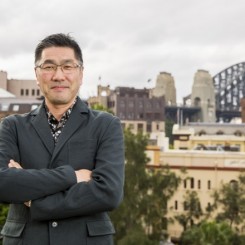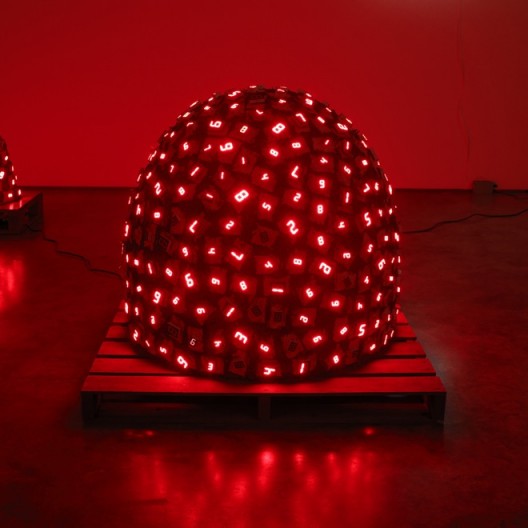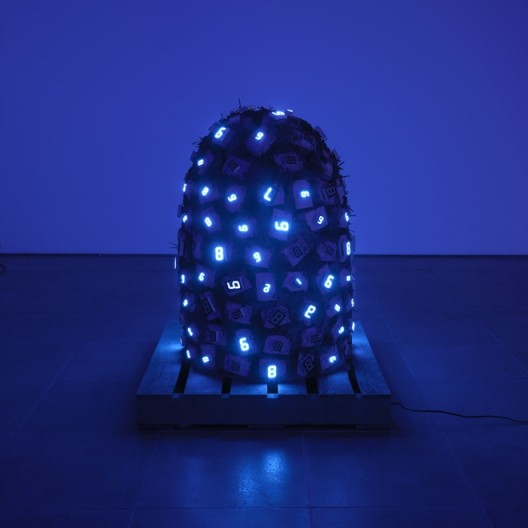“Tatsuo Miyajima: Connect with Everything”
Museum of Contemporary Art Australia, Sydney. Nov 3, 2016—Mar 5, 2017
Tatsuo Miyajima’s prominence as one of Japan’s leading contemporary artists—known widely for his deeply engaging and technologically driven installations, sculptures and video works founded on the Buddhist philosophy of exploring human cycles of life and mortality, death and renewal, and his three principles of “keep changing, connect with everything, and continue forever”—precedes any survey presentation of his art. Acclaimed installations such as “Mega Death” (1999/2016) and “Arrow of Time (Unfinished Life)” (2016) where the audience is engulfed in signature blue (and red) constellations of flickering and numerically descending LED numbers (from nine to one), and the “Counter Voice” video works in which individual performers count out loud before dipping their heads into a bowl of red wine/water/milk—both suggesting the human scale of life, pause and renewal—project the nucleus of three decades of Miyajima’s art. They present the viewer with lambent musings on their own speck of mortality amid mankind’s continuance and demise pointedly, through the agency of numbers. Numbers, both mutely and verbally projected.
The Museum of Contemporary Art Australia’s “Tatsuo Miyajima: Connect with Everything” is the continuation of the Sydney International Art Series at the MCA which has previously shown Annie Leibovitz, Rafael Lozano-Hemmer, Anish Kapoor, Yoko Ono, Chuck Close, and Grayson Perry. It is Miyajima’s first major exhibition in the Southern Hemisphere and Sydney (1), presenting the aforementioned installation and video works, and his less imperative but still pensive, meditative paintings (“Counter Painting on Kimono—Gold” and “Counter Painting on Kimono—Yellow”, both 2013), sculptures (“Pile Up Life No. 2″, 2009; “Warp Time with Warp Self No. 2″, 2010; “Diamond in You No. 8″, 2010; and “Life [Rhizome] No. 2″, 2012 among others), photographs (“Counter Skin in Hiroshima 2″ and “3″, 2007), and works on paper including sketch books—even blocks of typewriter imprinted zeroes on paper (“Empty Sets”, 1993). As an exhibition, “Connect with Everything” embodies scales of the micro and the macro, from the beginnings of Miyajima’s contemplations of the fragility of his own life (and life’s remaining time) to the immensity and infinitude of the universe, and from the more spectacular statements to mute and speculative pieces.
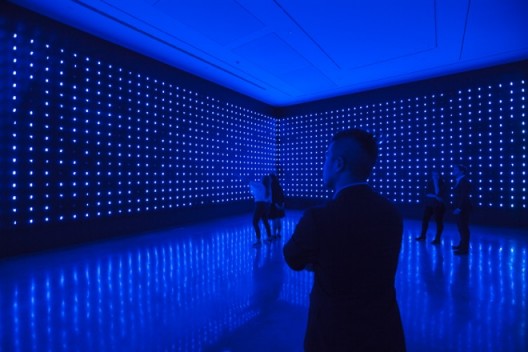
Tatsuo Miyajima, “Mega Death”, 1999/2016, installation view, Tatsuo Miyajima: Connect with Everything, Museum of Contemporary Art Australia, 2016, LED, IC, electric wire, infrared sensor, Domus Collection, image courtesy and © the artist, photograph: Alex Davies
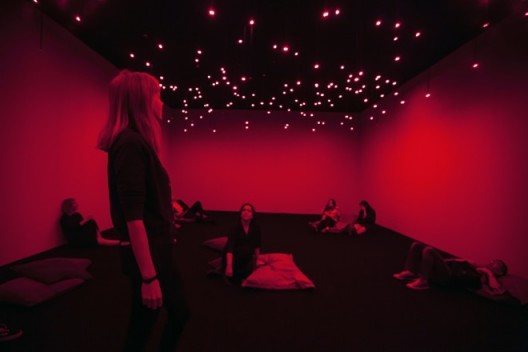
Tatsuo Miyajima, “Arrow of Time (Unfinished Life)”, 2016, installation view, Tatsuo Miyajima: Connect with Everything, Museum of Contemporary Art Australia, 2016, LED, IC, electric wire, iron, image courtesy and © the artist, photograph: Alex Davies
When young, Miyajima was twice hospitalized with a major illness, during which he experienced the passing of other children. This proximity to death had a resonant impact upon him, leaving him with a deep conviction about the value of life and the time one has to live that life in a meaningful and productive way. When at Tokyo University of the Arts in the early 1980s, he determined that he needed to become his own person, to be neither a mimic of Western art nor mediated by it. This ideology, underscored by Buddhist beliefs, sought self-expression initially through ephemeral performance—standing in a crowded square shouting or lying on the ground in the rain, his “shadow” momentary when he moved away.
Miyajima has said of Buddhism’s role in his art, “Buddhism allowed me to clarify my vision and direction, and helped me to understand why I was creating art and had become an artist. In other words, it clarified for me that I was making art for people, not for art.” For him, Buddhist thinking is about “not killing”, and “fighting against the evil” of human self-infliction. In his youth, Miyajima was deeply shocked during a school visit to Hiroshima which left him despairing for humanity. Such experiences and knowledge of other twentieth-century human tragedies have underscored the subject matter inherent in his major installations and videos. Looking at works in this exhibition such as “Counter Voice in the Water at Fukushima” (2014), “Mega Death” (1999/2016), “Counter Coal” (2008–2016) and “Train Time to the Holocaust” (2008) for example, despite Miyajima’s rejection of his work being interpreted as activist or political, do extend such sensibilities.
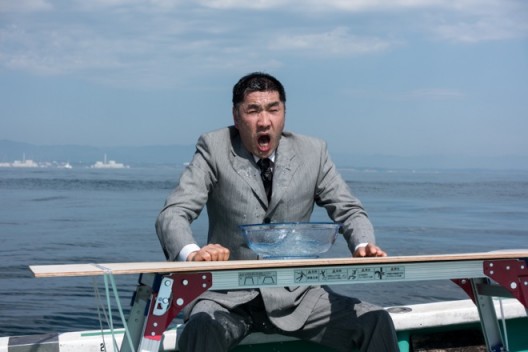
Tatsuo Miyajima, “Counter Voice in the Water at Fukushima (still)”, 2014, digital video, image courtesy the artist, Akio Nagasawa Gallery and SCAI THE BATHHOUSE © the artist
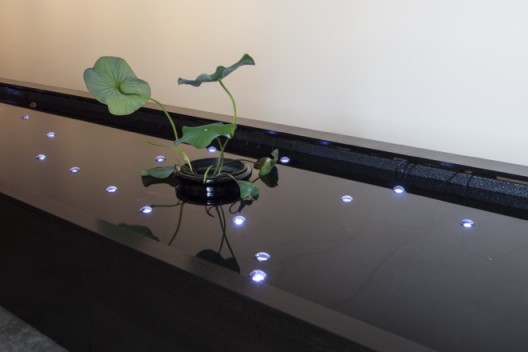
Tatsuo Miyajima, “100 Time Lotus (detail)”, 2008/2016, installation view, Tatsuo Miyajima: Connect with Everything, Museum of Contemporary Art Australia, 2016, LED, IC, electric wire, glass, water, Nymphaea lotus, Qiao Collection, image courtesy and © the artist, photograph: Alex Davies
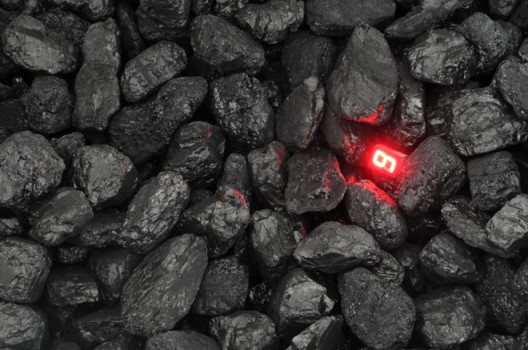
Tatsuo Miyajima, “Counter Coal (detail)”, 2008, installation view, Kunsthalle Recklinghausen, LED, IC, electric wire, coal, image courtesy the artist and Buchmann Galerie © the artist, photograph: Ferdinand Ullrich
In “Counter Voice in the Water at Fukushima”, the artist is the enumerator, a salaryman seemingly hermetically sealed in a waterproof suit and tie, sitting at a table before a clear bowl of radioactive seawater at the rear of a small boat bobbing off the coast of the damaged Fukushima Daiichi Nuclear power plant. The boat pitches cyclically in the waves, disengaging the camera’s point of view (and thus the viewer’s) of the performer and power plant in the background, reminding us of the tsunami that swept ashore in March 2011. Whereas in his other Counter Voice works the individual enumerators display various behavioral dispositions—application, commitment, resignation, hope, exasperation, affectation, exhaustion and so on—in “Counter Voice in the Water at Fukushima”, Miyajima’s Everyman appears almost as a tragicomic figure, a farce, of man’s capacity for folly or idiocy. Miyajima (reminiscent here of his countryman Toshiro Mifune scowling his way through countless Kurosawa films) theatrically shouts and mouths the descending numbers, agitated and excitable, growling and grimacing one moment, placid and subdued the next, before violently crashing or mildly immersing his head into the bowl of seawater. The histrionic quality of this performance of course belies gravity of its subject matter, with lingering radiation and suffering over Miyajima’s shoulder and beyond.
This incidental political dimension is extended in “Counter Coal”, coupled with “Train Time to Holocaust”. Referring to the extraction and systematic freighting of coal and its attendant WWII connotations of transportation to Nazi death camps, their union here also points to the often polemic domestic debate surrounding coal mining and climate change, the work’s blinking lights seemingly suggesting, as the toy train circumnavigates the seven tonnes of coal from Newcastle (north of Sydney), that “our days are numbered”, its dedicated tracking “railroading” us towards our collective demise. And of course, its LED lights require power to operate; Queensland and New South Wales bituminous coal is used for domestic power while Australia is the second largest exporter of coal in the world, with most of that trade going to Japan.
For all the conscious (and otherwise) responses Miyajima’s immersive, colored cipher constellations and spaces solicit—to the life cycle of humanity and the exploration of our mortality—I found the Counter Voice videos more intensely luminous. In these corporeal performances, repeated delivery and fluid cessations of the individual condition serve to enlighten conflicts between body and mind in ways that are truly humanizing.
1 Alan Cruickshank, as Executive Director at CACSA: Contemporary Art Centre of South Australia in Adelaide, commissioned Tatsuo Miyajima to produce 33 new video works—“Counter Voice in Milk Adelaide”, which exhibited Sep 9–Oct 30, 2005 at the CACSA, with three other works, “Counter Voice in Water” (1995), “Counter Voice in Air” (1995), and “Counter Voice in Wine” (2000).
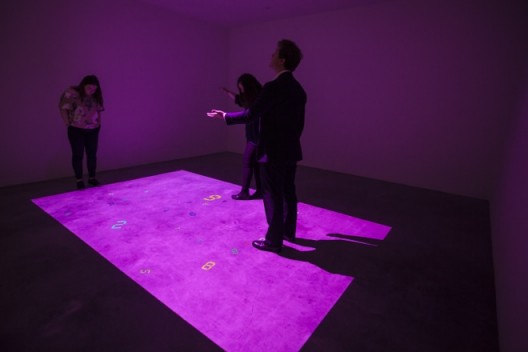
Tatsuo Miyajima, “Floating Time”, 2000/2016, installation view, Tatsuo Miyajima: Connect with Everything, Museum of Contemporary Art Australia, 2016, computer graphics, pc, projector, image courtesy and © the artist, photograph: Alex Davies
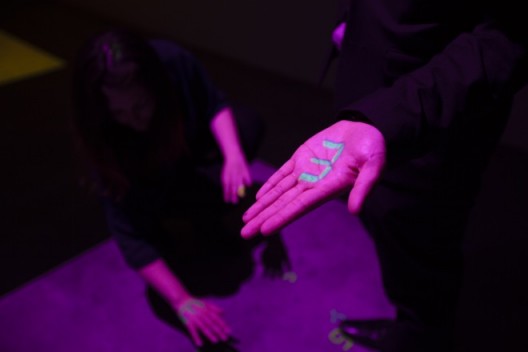
Tatsuo Miyajima, “Floating Time(detail)”, 2000/2016, installation view, Tatsuo Miyajima: Connect with Everything, Museum of Contemporary Art Australia, 2016, computer graphics, pc, projector, image courtesy and © the artist, photograph: Alex Davies
